Google Nexus 4 Review - Google's new Flagship
by Brian Klug on November 13, 2012 8:45 AM EST- Posted in
- Smartphones
- LG
- Android
- Mobile
- APQ8064
- Nexus 4
- Android 4.2
- MDM9215
Cellular, Wi-Fi, GNSS
Let’s talk about cellular on the Nexus 4, which is for many people the main point of contention with the device. Google didn’t do itself any favors by initially posting incorrect specs for cellular compatibility, when in fact the Nexus 4 was capable of much more. Initially, that spec table showed inclusion of only HSDPA 21.1 (single-carrier WCDMA with 64 QAM), when in fact the Nexus 4 supports pentaband WCDMA up to HSDPA 42.2 (dual-carrier WCDMA with 64 QAM) courtesy of MDM9215. Of course, what gets left out is LTE support, and the reality of that choice is a device completely detached from carrier involvement. The realities of engineering hardware to support both LTE Bands 17 and 13 (for both AT&T and Verizon in the USA, respectively) basically necessitate at least two SKUs, and I have a feeling that Google just wasn’t ready to make that commitment. Band 4 (AWS) could essentially be supported with the power amplifiers and transceiver that already are onboard the Nexus 4, but again it ultimately comes down to a particular OEM choice whether these get supported. The rest of the LTE band support situation is similarly complicated, to say nothing of the political involvement required to support LTE and whatever CSFB (circuit switched fallback) or legacy hard handover is required for each carrier at present. I have a feeling that Google wanted to get the Nexus 4 out the door quickly and without making a million and one models it would have to build images and OTA delta updates for, and the result is a pentaband WCDMA phone with DC-HSPA+ support.
When I heard that LG would be making the next Nexus, I also heard that it would be WCDMA only. Honestly I thought it was obvious that those two go hand in hand to minimize carrier involvement in Google’s purest form of Android. The original goal of Nexus was to change the way that users shop for handsets, primarily in the USA. The goals were lofty at that time and the reality was that Google didn’t yet have the necessary infrastructure (like the Play Store) to do it, nor was hardware at the level required to deliver a single-SKU solution for all the UMTS bands out there. Galaxy Nexus was the first pentaband Nexus, thus it only makes sense for the follow up to likewise be pentaband WCDMA.
Internationally, DC-HSPA+ has widespread support, the reality is that in the USA AT&T’s lack of support for DC-HSPA+ is more of an aberration than the norm for UMTS networks across the globe. Not having LTE support would be much easier to stomach for AT&T subscribers if the carrier enabled DC-HSPA+. T-Mobile has always been something of a silent (or not so silent) target for Google’s Nexus phones, with the G1, Nexus One, and Nexus S all coming in AWS-flavors before 850/1900 (Cellular/PCS) flavors for AT&T, and T-Mobile has had DC-HSPA+ rolled out to nearly all of its WCDMA footprint for months now.
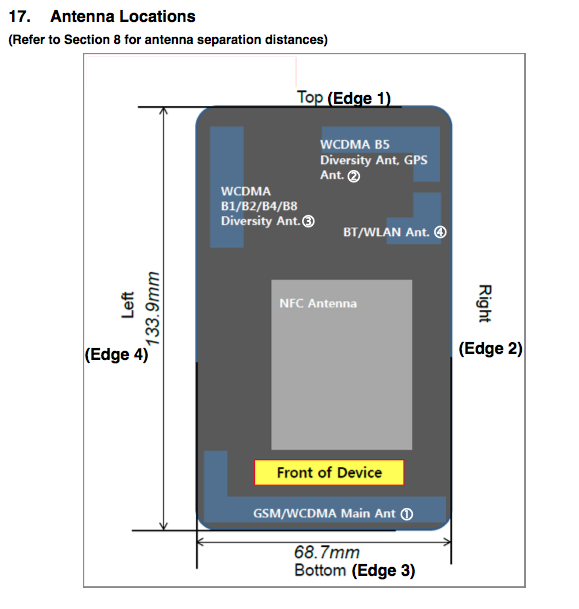
In reality, the cellular and RF architecture of the Nexus 4 is a dramatic improvement over the Galaxy Nexus, which was based on the still-ubiquitous Intel XMM6260 65nm baseband and lacked receive diversity or interference cancelation in its implementation. I was never really fully satisfied with RF performance on the Galaxy Nexus, and although I carried it as my daily driver for months, I could never shake that thought at the back of my head that I could definitely be achieving higher throughput with almost any of my other handsets even on AT&T (up to HSDPA 14.4, single carrier 16 QAM).
| Google Nexus 4 - Network Support | |||||
| GSM/EDGE Support | 850 / 900 / 1800 / 1900 MHz | ||||
| WCDMA Support | 850 / 900 / 1700 / 1900 / 2100 MHz | ||||
| Baseband Hardware | Qualcomm MDM9215M + WTR1605L | ||||
| UE Categories | HSDPA Category 24 (43.2 Mbps), HSUPA Category 6 (5.76 Mbps) | ||||
Anyhow, the Nexus 4 is a dramatic improvement. It includes the latest and greatest 28nm Qualcomm baseband (MDM9215M), their flagship transciever (WTR1605L) and includes full receive diversity on all WCDMA bands.
Anritsu recently loaned me an MD8475A signaling tester base station emulator for testing devices, and I decided to go and check out the maximum theoretical performance difference between the Galaxy Nexus and Nexus 4 just for illustrative purposes. In this test I corded up the Galaxy Nexus (since it has external antenna ports) and placed the Nexus 4 on top of an antenna, and setup a simulation running an HSPA+ 3GPP Release 8 network running on UMTS Band 4 (AWS). I tested using UDP over iperf on this simulated network. There were additional cabling losses due to me not being able to cable up the Nexus 4 so I adjusted Tx power appropriately.
Nexus 4 - HSDPA 42.2 (Dual Carrier)
Corded up, the Galaxy Nexus can eek out just over 19 Mbps on 64QAM single carrier WCDMA which is the maximum that hardware supports. Moving to dual carrier on the Nexus 4 buys the device unsurprisingly roughly double the throughput at just shy of 40 Mbps. This is of course in basically an ideal signal environment for both devices.
In real world performance testing I turned to speedtest.net and running a bunch of tests, then making a few histograms of the resulting data. I’m still a big fan of the fact that T-Mobile has always been first to these upgrades to WCDMA, first with 64QAM, then with dual carrier (DC-HSPA+).
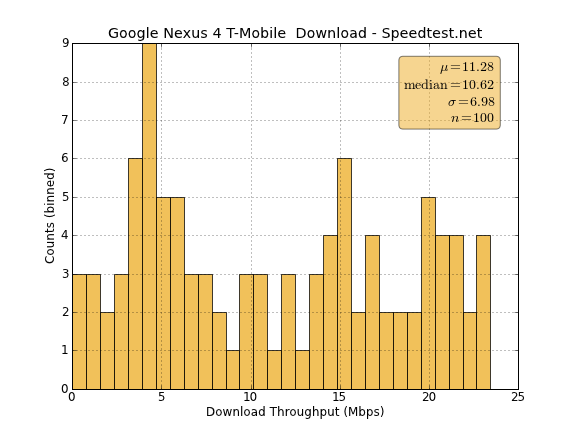
Stats Download Throughput (Mbps) Avg: 11.28, Max: 23.43, Min: 0.01, StDev: 6.98
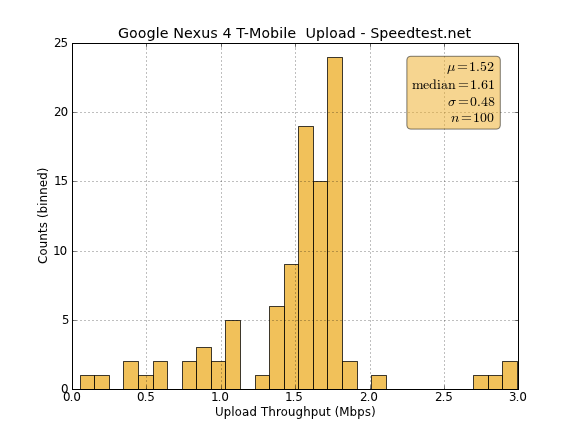
Stats Upload Throughput (Mbps) Avg: 1.52, Max: 2.99, Min: 0.05, StDev: 0.48
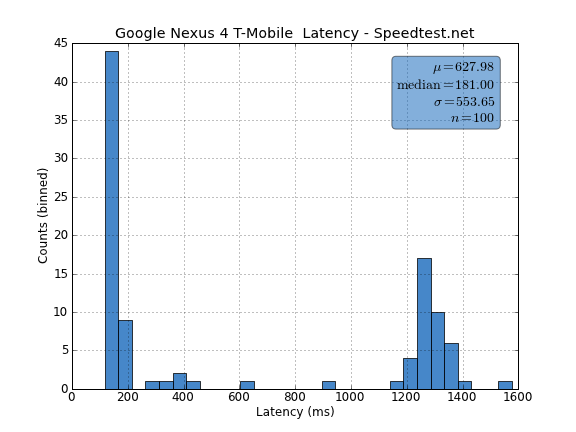
Stats Latency (ms) Avg: 627.98, Max: 1577.00, Min: 117.00, StDev: 553.65
The speeds I see out of the Nexus 4 on T-Mobile are on par with my expectations for that network. The maximum downstream throughput we see at just shy of 24 Mbps is essentially the result of the maximum bitrate with two 16QAM WCDMA carriers aggregated together. Again getting to 64QAM on the downlink can be quite difficult, I’ve seen breakdowns where 64QAM only gets used sub 10% of the time in the real world for WCDMA. At cell edge the improvement that receive diversity brings should be dramatic for users upgrading from Galaxy Nexus to Nexus 4.
GNSS
GNSS (Global Navigation Satellite System) is supplied courtesy MDM9215 on the Nexus 4, which offers GPS and GLONASS support. I’ve talked at length about this in other reviews, and like other implementations based around Qualcomm’s GNSS, the Nexus 4 locks very fast even indoors. There’s really nothing more to add about GNSS on the Nexus 4 except to note that it performs very well just like other MDM9x15 based devices I’ve played with.
There’s an Avago 3012 GNSS front end with LNA and filters for GPS and GLONASS on the Nexus 4 PCB that I was able to identify as well right near the GNSS antenna feed.
Wi-Fi
The Nexus 4 includes dual band (2.4 and 5 GHz) Wi-Fi support, which as far as I can tell is supplied by the Qualcomm “WCNSS” solution leveraging the digital baseband onboard APQ8064 and some external RF. I have no doubt the actual package is hidden under the last remaining EMI can I couldn’t remove on the Nexus 4 PCB right near the Wi-Fi antenna feed.
I noted that there’s an optimization toggle under Advanced for the Nexus 4 which changes some things around. There still is a band preference toggle as well. I tested the Nexus 4 the same way I always do with iperf on my myriad 802.11n networks and made some graphs.
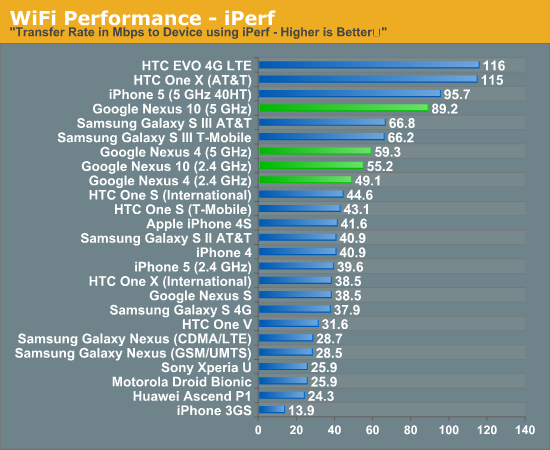
What’s curious to me is that the 5 GHz support for Nexus 4 doesn’t include 40 MHz support, instead the Nexus 4 attaches at 72 Mbps (the 20 MHz, short guard interval rate) on both 2.4 and 5 GHz. Likewise we see similar throughput on both bands. I have no complaints about range, the Nexus 4 is on par with my expectations.


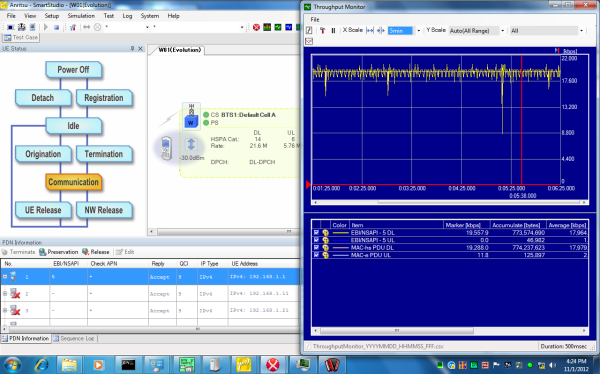
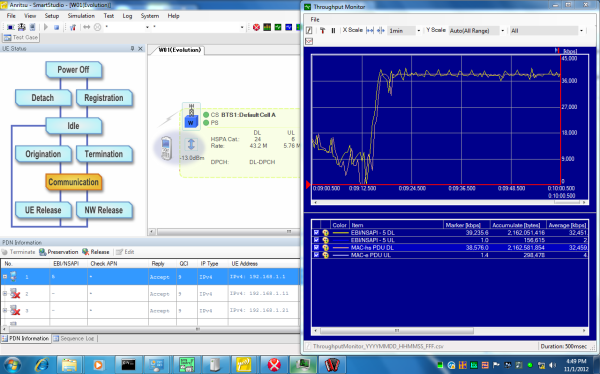








188 Comments
View All Comments
Freedomuser - Wednesday, November 14, 2012 - link
Not so fast. If the tests suite was intense like i think it's then even iphone 5 will get overheated.So, the question is, does any other phones in your chart survived the tests suite? LG Optimus G dropped out. Nexus 4 made it through with overheat. What about others on your chart?
meloz - Thursday, November 15, 2012 - link
>>Not so fast. If the tests suite was intense like i think it's then even iphone 5 will get overheated.But in this test it did not. And in any benchmark in which iphone5 will overheat, the Nexus 4 will overheat and throttl even worse!
I want Android and Nexus to do well, because they represent a more user-friendly (freedom) choice to iphone. But Google seriously need to address overheating, battery life and other such fundamental issues. Nexus 4 is a crappy device, at any price. I hope future software/firmware updates mitigate some of the problems.
piroroadkill - Thursday, November 15, 2012 - link
I don't care if this is the best phone ever, they've made a big mistake by missing out the microSD slot.Mugur - Thursday, November 15, 2012 - link
Just a small mistake in article: "First, audioflinger is set to 48 kHz which results in software resampling causing artifacts for 41.1 kHz source material.". It should be 44.1. not 41.1, I think...Mugur - Thursday, November 15, 2012 - link
Running a 3D game for one hour is one thing, but throttling in a benchmark does not look good.tipoo - Monday, December 24, 2012 - link
Yeah...I wonder if tiny heatsinks in it would solve this, and become a norm as phone SoCs aim for higher and higher performance.cyberguyz - Thursday, November 15, 2012 - link
Seems Google has a problem with allowing the user to expand his storage beyond what they give you. Why is that?The phone comes with 16gb internal flash memory, but no way of expanding it. This seems to be a popular trend with all Google-branded Nexus devices (Galaxy Nexus and Nexus 7 tablet are the same). The lack of sdcard support in an Android device kills the ability to set up a Windows drive letter for it. Without that drive letter many popular programs like Calibre have an issue attaching to the device to manage things like ebooks (this is a real pain in the ass with my nexus 7!!). I for one like the freedom popping in another 64GB microSD card gives me.
The lack of a removable battery also hurts this phone. I have hard experience with the life of li-Ion batteries losing capacity over time in laptops. Every couple years I have to get new batteries because the Li-Ion battery loses capacity until it cant keep my laptop alive for more than 20 minutes without dying. I like Samsungs because I can always replace the battery cheaply when it goes south and I don't have to send my phone (and private data) away for servicing to do it.
Beyond these two (as I consider them major) gripes, this is a really nice phone.
funky247 - Thursday, November 15, 2012 - link
With regard to the non-removable battery issue, most of the people I know don't like non-removable batteries because it limits their ability to whip out a backup battery when they need the extra juice while they're no the go.However, if the issue is with replacing the battery as it gets older, you can do it yourself! It even tells you how to do it in the review. You can buy authentic OEM batteries off of Ebay and do everything yourself, with the right tools. Some sellers will even ship the tools!
cyberguyz - Monday, November 19, 2012 - link
There are both of those issues with non-removable batteries.While the article tells you how to change the battery yourself, they do not mention that if you do that, you void your warranty (granted the warranty is gone after the battery goes south anyway). There are a lot of folks that cringe at the though of splitting open their $500-600 US phone to replace a battery.
I for one don't keep a #4 torx screwdriver around.
The ability to whip in a new battery in 2 sec without special tools in a vendor-blessed manner is a bit plus to me.
Now if only Samsung (or anyone else - I'm not a brand fanboy) would put out an Android-based phone with quad-core Krait or A15, 2GB memory, 32GB expandable storage and user-replaceable battery, I would ebay my SG3 in a heatbeat and be all over it.
Brandy123 - Thursday, November 15, 2012 - link
What I don't get is although the price and specs are very attractive for an unlocked: no contract phone, 8 or 16GB is really small by today's standards when there is no microSD slot! Google is obviously assuming you will be connected to the net 24/7 and streaming your music and videos via Google Play and other services. But then your data usage goes through the roof! Will this aggressive pricing force more carriers to offer truly unlimited data plans and more reasonable prices?Also, HPSA+ is fast enough for most, but lack of LTE is another compromise to get that good price. Yet it still is "the buzz" (note that the sellout time means nothing without knowing the number of units sold.)
So maybe the other key to the popularity of this device may be that with the younger generation, their phone is sort of a status symbol to them. Who can wait 2-years for contract renewal to get a new phone? But who can afford a $900 iPhone with no contract? BAM - Nexus 4 - I can get the latest gadget with specs good enough to brag about, with no contract, and without having to eat Top Ramen for a month to afford it. Who cares it doesn't have enough memory to store my video, photos and MP3 collection. I'll put it all on the Cloud and run my data usage through the roof instead.